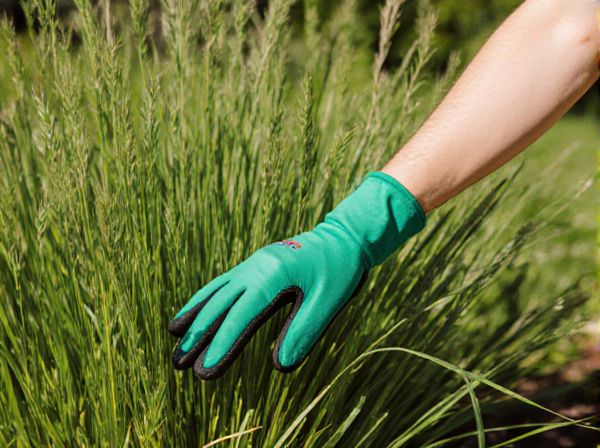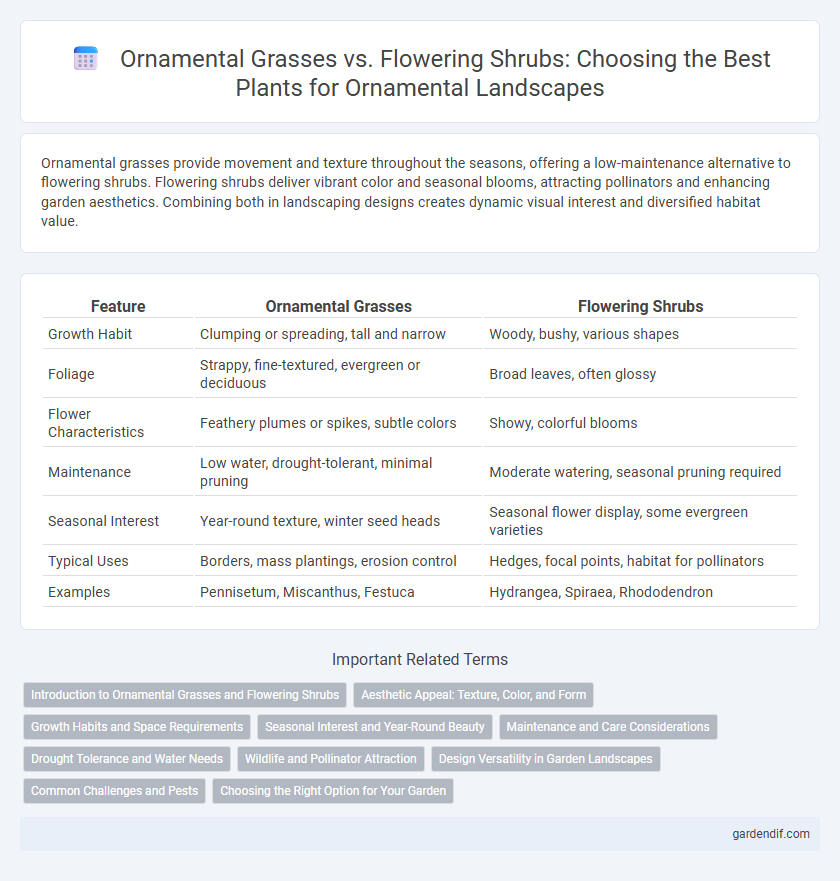
Ornamental Grasses vs Flowering Shrubs Illustration
Ornamental grasses provide movement and texture throughout the seasons, offering a low-maintenance alternative to flowering shrubs. Flowering shrubs deliver vibrant color and seasonal blooms, attracting pollinators and enhancing garden aesthetics. Combining both in landscaping designs creates dynamic visual interest and diversified habitat value.
Table of Comparison
| Feature | Ornamental Grasses | Flowering Shrubs |
|---|---|---|
| Growth Habit | Clumping or spreading, tall and narrow | Woody, bushy, various shapes |
| Foliage | Strappy, fine-textured, evergreen or deciduous | Broad leaves, often glossy |
| Flower Characteristics | Feathery plumes or spikes, subtle colors | Showy, colorful blooms |
| Maintenance | Low water, drought-tolerant, minimal pruning | Moderate watering, seasonal pruning required |
| Seasonal Interest | Year-round texture, winter seed heads | Seasonal flower display, some evergreen varieties |
| Typical Uses | Borders, mass plantings, erosion control | Hedges, focal points, habitat for pollinators |
| Examples | Pennisetum, Miscanthus, Festuca | Hydrangea, Spiraea, Rhododendron |
Introduction to Ornamental Grasses and Flowering Shrubs
Ornamental grasses add texture and movement to landscapes with their slender blades and seasonal seed heads, thriving in diverse climates and requiring low maintenance. Flowering shrubs offer vibrant seasonal color and structure, attracting pollinators and enhancing visual interest with blooms ranging from delicate to bold. Both plant types serve distinct aesthetic and ecological roles, complementing each other in garden design.
Aesthetic Appeal: Texture, Color, and Form
Ornamental grasses provide dynamic texture with their slender blades and graceful movement, creating a natural, flowing aesthetic that contrasts sharply with the denser, structured forms of flowering shrubs. Flowering shrubs contribute vibrant color bursts and varied flower shapes, enhancing visual interest and seasonal change in the garden landscape. Combining both elements elevates landscape design by balancing soft, airy textures against bold, colorful forms, enriching spatial depth and overall aesthetic appeal.
Growth Habits and Space Requirements
Ornamental grasses typically exhibit clumping or spreading growth habits, requiring moderate space with their tall, slender blades that create texture and movement in garden designs. Flowering shrubs grow more densely with branching structures that demand wider spacing to accommodate full blooms and healthy air circulation. Choosing between these plants hinges on available garden space and desired visual impact, as grasses offer flexibility in narrow areas while shrubs provide substantial mass and color.
Seasonal Interest and Year-Round Beauty
Ornamental grasses provide sweeping movement and texture throughout all seasons, offering golden hues in autumn and graceful seed heads in winter that enhance garden interest when flowering shrubs may be dormant. Flowering shrubs deliver vibrant color bursts primarily during their blooming months, creating focal points with blossoms that attract pollinators in spring and summer but often lose appeal during off-seasons. Combining ornamental grasses with flowering shrubs extends seasonal appeal and ensures year-round garden beauty by balancing evergreen structure and dynamic floral displays.
Maintenance and Care Considerations
Ornamental grasses require minimal maintenance, thriving with occasional watering and pruning, making them ideal for low-care landscapes. Flowering shrubs demand more consistent attention, including regular watering, fertilizing, and seasonal pruning to promote blooms and control growth. Selecting ornamental grasses over flowering shrubs can reduce labor and resource inputs in garden upkeep.
Drought Tolerance and Water Needs
Ornamental grasses exhibit higher drought tolerance compared to flowering shrubs, thriving in low-water environments due to their deep root systems and efficient water usage. Flowering shrubs typically require more consistent moisture levels to maintain bloom production, making them less ideal for xeriscaping or drought-prone areas. Selecting drought-tolerant ornamental grasses reduces irrigation needs, promoting sustainable landscaping practices.
Wildlife and Pollinator Attraction
Ornamental grasses provide essential shelter and nesting sites for various wildlife species while offering minimal nectar resources. Flowering shrubs deliver abundant pollen and nectar, making them crucial for attracting pollinators such as bees, butterflies, and hummingbirds. Integrating both plant types fosters a balanced ecosystem, supporting diverse pollinators and wildlife throughout the growing season.
Design Versatility in Garden Landscapes
Ornamental grasses offer exceptional design versatility in garden landscapes due to their texture, movement, and seasonal interest, providing year-round appeal with minimal maintenance. Flowering shrubs contribute vibrant colors and varied bloom times, enhancing aesthetic diversity and attracting pollinators. Combining both elements creates dynamic compositions that balance structure and softness, elevating garden design through contrasting heights, forms, and color palettes.
Common Challenges and Pests
Ornamental grasses often struggle with fungal diseases like rust and leaf spot, while flowering shrubs commonly face aphid infestations and powdery mildew. Both plant types require regular monitoring for pest control, particularly for spider mites and scale insects that can damage foliage and reduce aesthetic appeal. Proper air circulation and targeted treatments are essential to maintain plant health and prevent common challenges in ornamental landscaping.
Choosing the Right Option for Your Garden
Ornamental grasses provide year-round texture and movement with low maintenance, making them ideal for creating natural, flowing landscapes, while flowering shrubs offer vibrant seasonal color and structured forms essential for focal points in garden design. Consider climate adaptability, soil conditions, and desired visual impact when selecting between these options to ensure healthy growth and aesthetic harmony. For drought-tolerant gardens, ornamental grasses like Miscanthus and Pennisetum thrive, whereas flowering shrubs such as Hydrangeas and Azaleas suit moist, nutrient-rich environments.
Ornamental Grasses vs Flowering Shrubs Infographic

 gardendif.com
gardendif.com